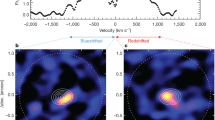Abstract
Circumstellar disks are an essential ingredient of the formation1 of low-mass stars. It is unclear, however, whether the accretion-disk paradigm can also account for the formation of stars more massive than about 10 solar masses2, in which strong radiation pressure might halt mass infall3,4. Massive stars may form by stellar merging5, although more recent theoretical investigations suggest that the radiative-pressure limit may be overcome by considering more complex, non-spherical infall geometries6,7. Clear observational evidence, such as the detection of compact dusty disks8 around massive young stellar objects, is needed to identify unambiguously the formation mode of the most massive stars. Here we report near-infrared interferometric observations that spatially resolve the astronomical-unit-scale distribution of hot material around a high-mass (∼20 solar masses) young stellar object. The image shows an elongated structure with a size of ∼13 × 19 astronomical units, consistent with a disk seen at an inclination angle of ∼45°. Using geometric and detailed physical models, we found a radial temperature gradient in the disk, with a dust-free region less than 9.5 astronomical units from the star, qualitatively and quantitatively similar to the disks observed in low-mass star formation. Perpendicular to the disk plane we observed a molecular outflow and two bow shocks, indicating that a bipolar outflow emanates from the inner regions of the system.
This is a preview of subscription content, access via your institution
Access options
Subscribe to this journal
Receive 51 print issues and online access
$199.00 per year
only $3.90 per issue
Buy this article
- Purchase on Springer Link
- Instant access to full article PDF
Prices may be subject to local taxes which are calculated during checkout


Similar content being viewed by others
References
McKee, C. F. & Ostriker, E. C. Theory of star formation. Annu. Rev. Astron. Astrophys. 45, 565–687 (2007)
Zinnecker, H. & Yorke, H. W. Toward understanding massive star formation. Annu. Rev. Astron. Astrophys. 45, 481–563 (2007)
Kahn, F. D. Cocoons around early-type stars. Astron. Astrophys 37, 149–162 (1974)
Wolfire, M. G. & Cassinelli, J. P. Conditions for the formation of massive stars. Astrophys. J. 319, 850–867 (1987)
Bonnell, I. A., Bate, M. R. & Zinnecker, H. On the formation of massive stars. Mon. Not. R. Astron. Soc. 298, 93–102 (1998)
McKee, C. F. & Tan, J. C. Massive star formation in 100,000 years from turbulent and pressurized molecular clouds. Nature 416, 59–61 (2002)
Krumholz, M. R. et al. The formation of massive star systems by accretion. Science 323, 754–757 (2009)
Cesaroni, R., Galli, D., Lodato, G., Walmsley, C. M. & Zhang, Q. in Protostars and Planets V (eds Reipurth, B., Jewitt, D. & Keil, K.) 197–212 (University of Arizona Press, 2007)
Grave, J. M. C. & Kumar, M. S. N. Spitzer-IRAC GLIMPSE of high mass protostellar objects. II. SED modelling of a bona fide sample. Astron. Astrophys. 498, 147–159 (2009)
Beltrán, M. T. et al. Search for massive protostellar candidates in the southern hemisphere. II. Dust continuum emission. Astron. Astrophys. 447, 221–233 (2006)
Benjamin, R. A. et al. GLIMPSE. I. An SIRTF legacy project to map the inner Galaxy. Publ. Astron. Soc. Pacif. 115, 953–964 (2003)
Fontani, F. et al. Search for massive protostellar candidates in the southern hemisphere. I. Association with dense gas. Astron. Astrophys. 432, 921–935 (2005)
Cabrit, S., Edwards, S., Strom, S. E. & Strom, K. M. Forbidden-line emission and infrared excesses in T Tauri stars — evidence for accretion-driven mass loss? Astrophys. J. 354, 687–700 (1990)
Blandford, R. D. & Payne, D. G. Hydromagnetic flows from accretion discs and the production of radio jets. Mon. Not. R. Astron. Soc. 199, 883–903 (1982)
Petrov, R. G. et al. AMBER, the near-infrared spectro-interferometric three-telescope VLTI instrument. Astron. Astrophys. 464, 1–12 (2007)
Hofmann, K.-H. & Weigelt, G. Iterative image reconstruction from the bispectrum. Astron. Astrophys. 278, 328–339 (1993)
Kraus, S. et al. Tracing the young massive high-eccentricity binary system θ1 Orionis C through periastron passage. Astron. Astrophys. 497, 195–207 (2009)
Tobin, J. J. Imaging scattered light from the youngest protostars in L1448: signatures of outflows. Astrophys. J. 659, 1404–1419 (2007)
Eisner, J. A. et al. Spectrally dispersed K-band interferometric observations of Herbig Ae/Be sources: inner disk temperature profiles. Astrophys. J. 657, 347–358 (2007)
Kraus, S., Preibisch, T. & Ohnaka, K. Detection of an inner gaseous component in a Herbig Be star accretion disk: near- and mid-infrared spectrointerferometry and radiative transfer modeling of MWC 147. Astrophys. J. 676, 490–508 (2008)
Chiang, E. I. & Goldreich, P. Spectral energy distributions of T Tauri stars with passive circumstellar disks. Astrophys. J. 490, 368–376 (1997)
Monnier, J. D. et al. The near-infrared size-luminosity relations for Herbig Ae/Be disks. Astrophys. J. 624, 832–840 (2005)
Robitaille, T. P., Whitney, B. A., Indebetouw, R., Wood, K. & Denzmore, P. Interpreting spectral energy distributions from young stellar objects. I. A grid of 200,000 YSO model SEDs. Astrophys. J. 167, 256–285 (2006)
Robitaille, T. P., Whitney, B. A., Indebetouw, R. & Wood, K. Interpreting spectral energy distributions from young stellar objects. I. Fitting observed SEDs using a large grid of precomputed models. Astrophys. J. 169, 328–352 (2007)
Whitney, B. A., Wood, K., Bjorkman, J. E. & Wolff, M. J. Two-dimensional radiative transfer in protostellar envelopes. I. Effects of geometry on class I sources. Astrophys. J. 591, 1049–1063 (2003)
Bodenheimer, P. Angular momentum evolution of young stars and disks. Annu. Rev. Astron. Astrophys. 33, 199–238 (1995)
Bonnell, I. A. & Bate, M. R. Binary systems and stellar mergers in massive star formation. Mon. Not. R. Astron. Soc. 362, 915–920 (2005)
Bernasconi, P. A. & Maeder, A. About the absence of a proper zero age main sequence for massive stars. Astron. Astrophys. 307, 829–839 (1996)
Hollenbach, D. J., Yorke, H. W. & Johnstone, D. in Protostars and Planets IV (eds Mannings, V., Boss, A. P. & Russell, S. S.) 401–428 (Univ. Arizona Press, 2000)
Smith, H. A. et al. Outflows from massive young stellar objects as seen with the infrared array camera. Astrophys. J. 645, 1264–1271 (2006)
Acknowledgements
This work was done in part under contract with the California Institute of Technology (Caltech), funded by NASA through the Sagan Fellowship Program (S.K. is a Sagan Fellow). We thank the ESO Paranal staff for support and their efforts in improving the VLTI. This paper is based on observations made with ESO telescopes at the La Silla Paranal Observatory and archival data obtained with the Spitzer Space Telescope, operated by the Jet Propulsion Laboratory, Caltech, under a contract with NASA. We also used data acquired with APEX, a collaboration between the Max-Planck-Institut für Radioastronomie, ESO, and the Onsala Space Observatory.
Author information
Authors and Affiliations
Contributions
S.K. worked on the AMBER data reduction and data interpretation, model fitting and image reconstruction, made some of the observations and wrote the telescope proposals and the initial paper manuscript. K.-H.H. worked on the image reconstruction. D.S. worked on the speckle data reduction. G.W. made some of the observations. F.W. worked on the APEX data reduction and data interpretation. K.M.M. and P.S. were co-authors on the telescope proposal. A.M., K.P., R.P., S.R.-D. and L.T. represent the AMBER instrument consortium, which provided some observation time. All authors commented on the paper.
Corresponding author
Ethics declarations
Competing interests
The authors declare no competing financial interests.
Supplementary information
Supplementary Information
This file contains Supplementary Information, Notes and Data S1-S5, Supplementary Tables S1-S4, Supplementary Figures S1-S15 with legends and References. (PDF 5203 kb)
PowerPoint slides
Rights and permissions
About this article
Cite this article
Kraus, S., Hofmann, KH., Menten, K. et al. A hot compact dust disk around a massive young stellar object. Nature 466, 339–342 (2010). https://doi.org/10.1038/nature09174
Received:
Accepted:
Issue Date:
DOI: https://doi.org/10.1038/nature09174
This article is cited by
-
A Keplerian disk with a four-arm spiral birthing an episodically accreting high-mass protostar
Nature Astronomy (2023)
-
Massive stars in extremely metal-poor galaxies: a window into the past
Experimental Astronomy (2021)
-
Formation and Evolution of Disks Around Young Stellar Objects
Space Science Reviews (2020)
-
Measuring the ionisation fraction in a jet from a massive protostar
Nature Communications (2019)
-
A recent history of science cases for optical interferometry
Experimental Astronomy (2018)
Comments
By submitting a comment you agree to abide by our Terms and Community Guidelines. If you find something abusive or that does not comply with our terms or guidelines please flag it as inappropriate.



